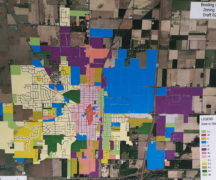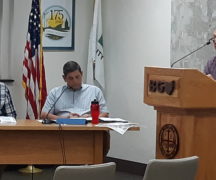By JAN LARSON McLAUGHLIN
BG Independent News
Bowling Green officials got a first peek Monday at a zoning update intended to reduce the hoops for new businesses, and increase the right types of development in the right places in the city.
The plan is in its “sausage making” middle stage, when it gets messy, according to Sean Sudar, of the ZoneCo firm which is working on the update.
The update will simplify zoning for the city and for new development. Instead of the 25 current zoning categories, the new code will have eight zones and five districts, Sudar said.
“We try to create a code that’s easily used,” Sudar said. “It should communicate complex matters in a simplistic way.”
The new plan will be designed to help create a local identity for Bowling Green.
“We don’t want it to be ‘Anywhere, USA,’” Sudar said.
Community goals for the new code include:
- Simplification and modernization.
- Remove barriers to new businesses.
- Create a walkable urban center.
- Gateway.
- Local identity, place-making.
- Housing options.
- Maintenance of neighborhoods.
- Health and fitness.
The city’s current zoning code is outdated, Sudar said.
“This is traditional – what you would see in cities across the country. How they used to do it,” he said. “This isn’t really getting you to your vision.”
Instead of restricting business to areas separate from residential areas, the new zoning will allow for small shops in neighborhoods. The plan would allow pop-up businesses like a coffee shop or microbrewery.
The existing zoning code is cumbersome to use and raises the cost and friction involved with development, Sudar said
“We don’t want to create barriers to those,” he said.
Diversity in housing will be one of the goals.
“So people at all ends of the spectrum can live – and stay in Bowling Green,” he said.
The plan will examine ways to make the downtown area more walkable.
“How do we connect it better to the rest of the city,” he said.
The update will also encourage more walking and less driving. That will lead to healthier residents and less land being dedicated to parking lots in front of businesses.
And it will keep working on the “gateway” area on East Wooster Street.
“We want to connect the downtown and university,” Sudar said.
Nolan Nicaise, from ZoneCo, described the creation of the eight “zones,” which can be located throughout the city, and five “districts,” which are for five distinct areas.
New zoning categories suggested include:
- Low density residential zone – to preserve neighborhoods of one-unit dwellings in low-density areas.
- Medium density residential zone – to maintain residential neighborhoods of one- and two-unit dwellings in medium density areas.
- Multi-family residential zone – to maintain high density residential neighborhoods with multi-unit dwellings.
- Neighborhood commercial zone – to promote a mix of lot sizes and uses to provide nearby residents with convenient access to shops, services and employment opportunities.
- Innovation and employment zone – to promote a broad mix of commercial and industrial uses that support economic activity by supplying services, products, innovation and employment.
- Institutional zone – to promote institutional land uses, such as schools, libraries, a public hospital, and centers for arts and sciences.
- Agricultural zone – to preserve the agricultural character of specific areas of Bowling Green with large lots for agricultural production.
- Recreational conservation zone – to protect and perpetuate a system of permanent parks and recreational uses for residents.
- Pedestrian residential district – to promote walkable neighborhoods with residential uses and some businesses.
- University-oriented residential district – to promote mix of residential and commercial uses within walking distance of BGSU.
- Interstate commerce district – for a mix of lodging, commercial and retail establishments.
- Central business district – to promote vitality of Bowling Green’s historic downtown, with buildings close to the street, shopfronts with transparent facades, and a broad mix of uses.
- Gateway district – to promote development of a higher intensity, urban neighborhood center along East Wooster Street between Manville Avenue/Thurstin Avenue and Enterprise Street – serving as a gateway and vibrant connection between BGSU and downtown Bowling Green.
All current land uses would be grandfathered in. The properties that don’t fit the new zoning would be called “legal non-conforming” uses, Nicaise said.
Sudar said city officials may want to consider a moratorium on zoning changes at some point, so last minute requests don’t sneak in under the wire.
The proposed zoning update will be placed on the city’s website, with the public being able to comment on the plan.
“We don’t have all the answers. It’s your community,” Sudar said.




